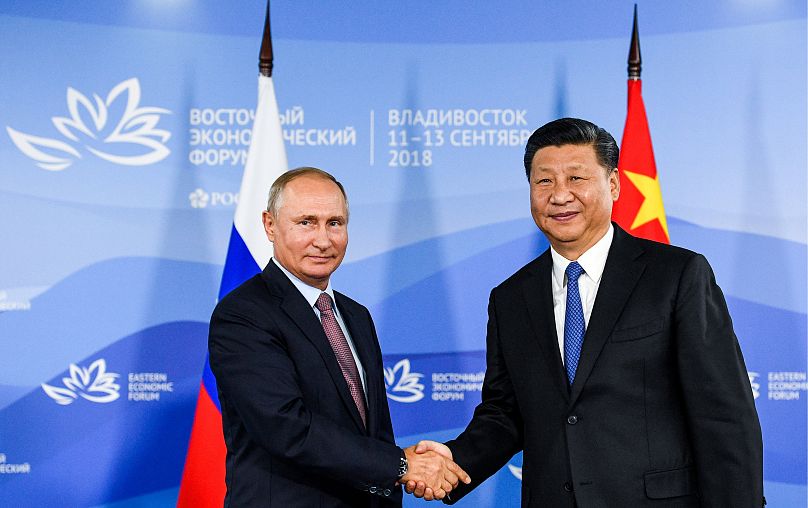For the past two days, the Russian military has been conducting the country's biggest drills in decades, as President Vladimir Putin seeks to send a message to the West but also to his own increasinly-dissatisfied electorate.
For the past two days, the Russian military has been conducting the country's biggest drills in decades, as President Vladimir Putin seeks to send a message to the West — but also to his own increasingly-dissatisfied electorate.
Euronews explains why the most-recent drills are significant.
Largest drills since the Soviet era
According to the Russian defence ministry, the Vostok-2018 military exercises, which launched on Tuesday and are scheduled to end on Saturday, are the country's biggest since 1981. They allegedly involve some 300,000 troops and include contingents from neighbours China and Mongolia.
A thousand planes, helicopters and drones, up to 80 ships and 36,000 tanks, armoured personnel carriers and other vehicles are to be used, according to the ministry.
The drills take place in the country's far-east — Vostok means "East" — and will see close collaborations between ground, air and specialist units as well as the deployment of reconnaissance and electronic warfare.
Experts, however, have cast doubt on the number of troops involved.
"Russia has strong incentives to provide misleading numbers on the size of its exercises — claiming that those in the West, like Zapad-2017, are smaller than they really are, and those in the East, like Vostok, are larger," Keir Giles, senior research fellow at London-based think-tank Chatham House, told Euronews.
That's because Western countries can request to send inspectors under the Organization for Security and Cooperation in Europe rules if exercises involve more than 15,000 troops.
Why the West cares
Russia regularly conducts military drills and in the past has used these often-surprise exercises to launch attacks, including the invasion of Georgia in 2008 and the annexation of Crimea from Ukraine in 2014.
In the past two years, it's appeared to have ramped up its drills in scale and complexity. Russia said 12,000 troops took part in last year's Zapad ("West") exercises on the borders with NATO countries although estimates from observers ranged from 30,000 to 100,000.
Of particular interest for the West will be what Russia's army has learnt from the conflicts it's currently involved in, according to Emily Ferris, a research fellow at the London-based RUSI think-tank.
"For almost ten years, the Russian army has been undergoing widespread modernisation of its troops and equipment.
"Russia’s military involvement in the conflicts in eastern Ukraine and Syria are both informing their experiences of battle, and the military is adapting its tactics and technology accordingly, as well as using this as an opportunity to demonstrate its new equipment," she told Euronews.
Ferris explained, however, that most of Russia's armed companies are under international sanctions, "which makes it difficult for them to locate international partners" and mean its "defence industry still lacks a lot of components".
Still, NATO spokesman Dylan White, who announced in late August that NATO had been briefed about the drills, said on Twitter: "Vostok demonstrates Russia's focus on exercising large-scale conflict. It fits into a pattern... a more assertive Russia significantly increasing its defence budget & its military presence."
Why they're particularly important to Putin
Russia has found itself increasingly isolated diplomatically as western nations sanctioned the country for its actions in Ukraine, blamed it for the Novichok nerve agent attack against a former Russian spy in Britain earlier this year and accused it of election meddling. Russia vehemently denies the latter two allegations.
The show of force is a way for Putin to "ensure that its armed forces are as ready as possible to engage in conflict, and that potential adversaries receive an impression of enormous armed power in order to deter them," Giles told Euronews.
It also plays well in a country that prides itself of its military might and comes at an opportune time for Putin, whose ratings have slipped since announcing a rise in the pension age, prompting wide-spread protests across the country.
The drills, Giles said, might "reassure Russians that however much their standard of living may be deteriorating under the current leadership, at least Russia once again has a powerful army to console itself with."
Russia's shift to the East
It is not the first time China has joined Russia for military drills but this year is particularly significant, Ferris explained, because it's "part of Russia's strategy to symbolically and politically align itself with China, as a counter-balance to the US's geopolitical influence."
The two countries are tied by their mutual security concerns over North Korea's nuclear programme and are increasingly cooperating in Syria. Russia is an active military participant backing Syria's regime leader Bashar al-Assad, while China is interested in post-conflict investment.
"It is also significant that these exercises coincide with the Eastern Economic Forum (EEF) in Russia’s far-east region of Vladivostok — an annual event designed to promote foreign and domestic investment in the Far East," Ferris said.
"Russia is very interested in attracting investment from Japan and China, particularly in infrastructure," she added, noting that President Xi Jinping attended the EEF this year.












